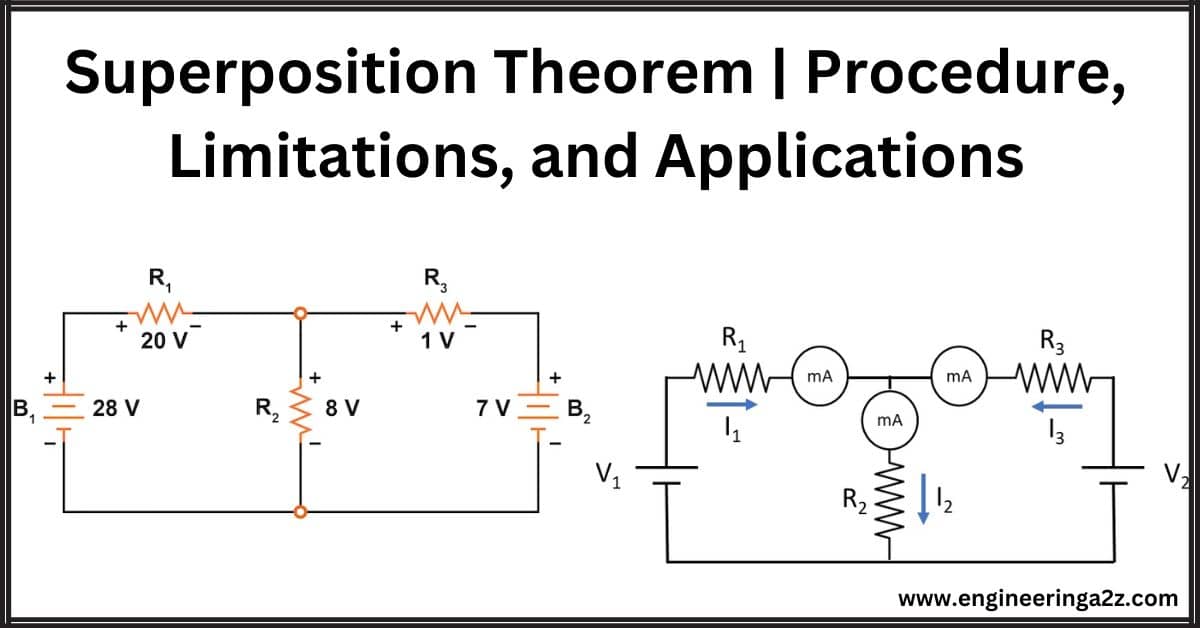
Table of Contents
Introduction
The superposition theorem states that the voltage or current in any part of a linear circuit with multiple sources is equal to the sum of the voltages or currents caused by each source acting alone.
The superposition theorem is like understanding how different musicians add up to create a song. Imagine a band with many musicians playing different instruments. The theorem says we can figure out how each musician contributes to the music by listening to them individually and adding up their parts.
So, if you have a circuit with many independent sources (like different musicians playing), you can look at how each one affects the circuit separately. To do this, you pretend the other sources aren’t there by either turning off or ignoring their influence.
For example, if you have multiple musicians playing instruments, to hear what each one adds to the song, you’d listen to each musician’s part separately and then combine them to understand the complete song.
To focus on one source’s effect, you make the others “quiet” by either short-circuiting voltage sources (like muting a guitarist by touching the strings) or opening the terminals of current sources (like silencing a drummer by lifting the drumsticks).
This method helps understand how each source affects the flow of electricity in a specific part of the circuit (like the current in a wire or the voltage across a component). You do this as often as there are independent sources to get the complete picture, just like listening to each musician in the band separately to understand their contribution to the song.
Guidelines While Using The Superposition Theorem
- Taking out an ideal voltage source is like making a shortcut in the circuit. It’s as if you connect the two ends of where the voltage source was directly together.
- Removing the ideal current source is like putting up a roadblock in the circuit. You create a gap in the circuit where the current source used to be.
- When you remove a real-world voltage source (a practical one), it’s like adding a bumpy road in the circuit. Instead of just taking it out, you put a rough patch that slows down the electricity. This “bumpy part” is the internal resistance of the source, changing how the electricity flows.
Prerequisites for Using the Superposition Theorem
For the Superposition Theorem to work well, all the parts in the circuit need to act consistently and not change over time. It’s like using a recipe where the ingredients always behave the same way and don’t change taste or texture while you’re cooking.
But if you have ingredients that keep changing or don’t follow the same rules, it’s like trying to bake a cake when some ingredients don’t always taste the same or behave predictably. That unpredictability makes it tough to use the theorem accurately.
How to Apply Superposition Theorem?
- Start by picking one source from all the sources in the circuit.
- Turn off or “mute” all the other sources by replacing them with their inside stuff (like using earplugs for other sources).
- Figure out what happens to the current or voltage in a specific part of the circuit (like a wire or a component).
- Repeat this same process for each of the other sources, one at a time.
- Once you’ve checked each source separately, add up all the effects you found to see how it all adds together for that part of the circuit. It’s like combining all the separate things you heard to understand the whole music track.
Procedure of Superposition Theorem
- Look at how one power source affects a specific part of the circuit by ignoring the other.
- Do the same for each power source, one at a time, to see how they each affect that part of the circuit.
- Add up all those effects from each power source to see how everything together affects that part of the circuit when all the power sources are working together. It’s like understanding how different ingredients change the taste of a dish – here, we’re seeing how each power source affects the electricity flow, then adding it all up to understand the whole impact.
Example: Find the current flowing through 20 Ω using the superposition theorem.
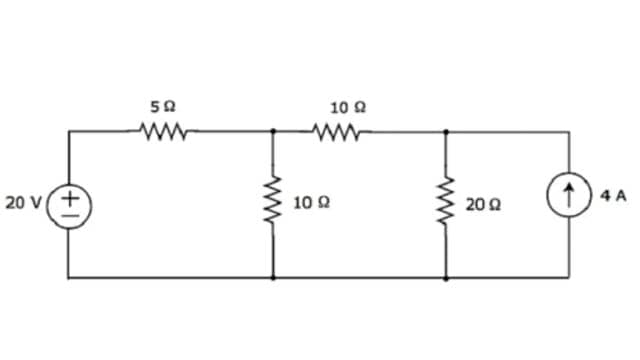
Step 1 − Let us find the current flowing through a 20 Ω resistor by considering only a 20 V voltage source. In this case, we can eliminate the 4 A current source by making an open circuit of it. The modified circuit diagram is shown in the following figure.
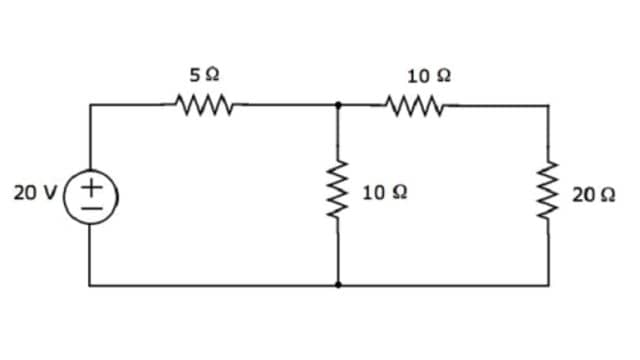
There is only one principal node except Ground in the above circuit. So, we can use the nodal analysis method. The node voltage V1 is labeled in the following figure. Here, V1 is the voltage from node 1 concerning ground.
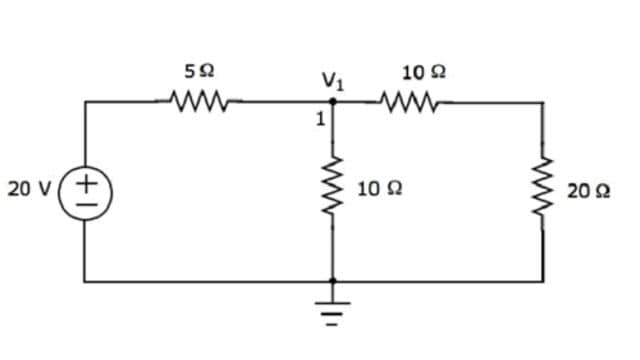
The nodal equation at node 1 is

The current flowing through a 20 Ω resistor can be found by doing the following simplification.

Substitute the value of V1 in the above equation.

Therefore, the current flowing through the 20 Ω resistor is 0.4 A, when only a 20 V voltage source is considered.
Step 2 − Let us find the current flowing through a 20 Ω resistor by considering only a 4 A current source. In this case, we can eliminate the 20 V voltage source by making a short circuit of it. The modified circuit diagram is shown in the following figure.
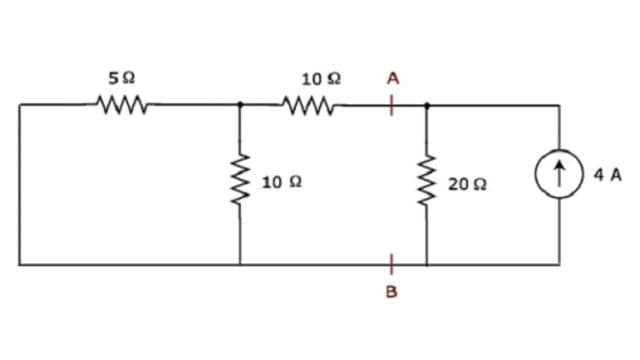
In the above circuit, there are three resistors to the left of terminals A & B. We can replace these resistors with a single equivalent resistor. Here, 5 Ω & 10 Ω resistors are connected in parallel and the entire combination is in series with a 10 Ω resistor.
The equivalent resistance to the left of terminals A & B will be

The simplified circuit diagram is shown in the following figure.
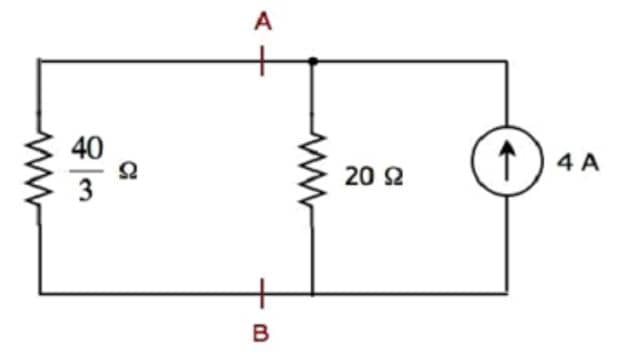
We can find the current flowing through a 20 Ω resistor, by using the current division principle.
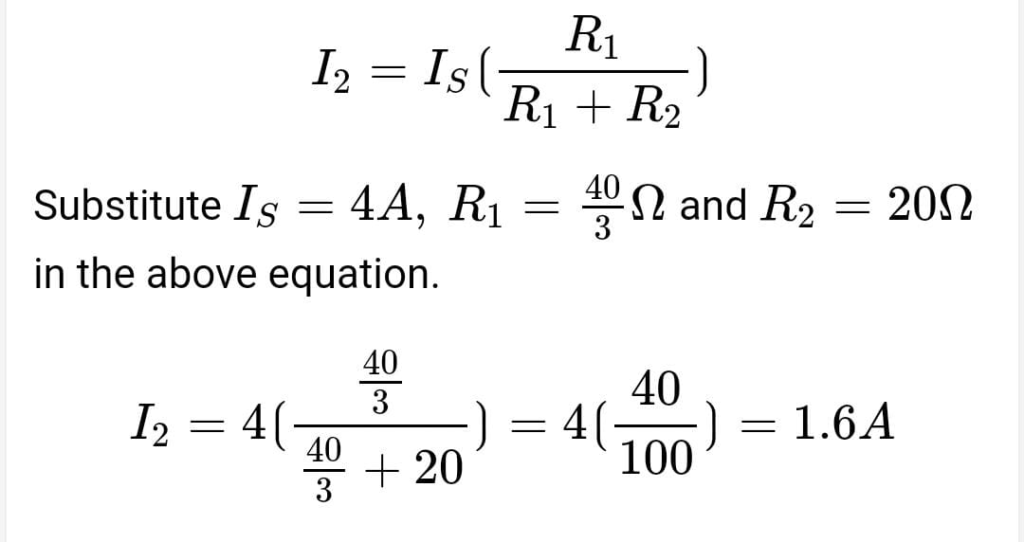
Therefore, the current flowing through the 20 Ω resistor is 1.6 A, when only a 4 A current source is considered.
Step 3 − We will get the current flowing through the 20 Ω resistor of the given circuit by doing the addition of two currents that we got in Step 1 and Step 2. Mathematically, it can be written as
I = I1 + I2
Substitute, the values of I1 and I2 in the above equation.
I = 0.4 + 1.6 = 2A
Therefore, the current flowing through the 20 Ω resistor of the given circuit is 2 A.
Limitations of Superposition Theorem
- This theorem can’t figure out how much power is used in a circuit. It’s like trying to measure how much energy a bunch of ingredients contribute to a dish when you’re only tasting each ingredient separately.
- If a circuit isn’t balanced or has uneven parts, this theorem won’t work well. It’s like trying to balance a see-saw when one side is heavier than the other – it doesn’t work smoothly.
- This theorem only works for circuits where everything behaves the same way all the time, like using the same recipe that always turns out the same cake.
- You need a circuit with multiple sources (like batteries or power supplies) for this theorem to do its thing. It’s like understanding how different things mix in a recipe; you need more than just one ingredient to see how they all work together.
Applications of Superposition Theorem
- This theorem works for circuits with basic parts, like resistors or similar things that follow Ohm’s law. It’s like having a method that only works for recipes with ingredients that always behave in a simple, predictable way.
- It helps find out how much electricity flows in different parts of a circuit when there are two or more power sources, like batteries or things that make electricity. It’s like figuring out how different ingredients affect the taste of a dish – here, we’re seeing how different power sources affect the flow of electricity in a circuit.
Frequently Asked Questions (FAQs)
What is the theory of superposition?
When waves come together, their combined effect is like adding up their movements. This happens for waves in water, sound, and light, where overlapping waves create a sum of their individual effects.
What is a superposition of charge?
When many charges are around, the total force on one charge is the result of adding up forces from all other charges. The force between two charges isn’t changed by other charges nearby.
What is a superposition theorem statement short?
The superposition theorem says that if you have a bunch of different power sources in a circuit, you can figure out what happens by looking at each source separately and then adding up all those individual situations to get the full picture.
Read Also:
- Circuit Theorem | Thevenin’s Theorem
- Basic Electrical Engineering | Engineeringa2z
- Fundamentals of Electric Circuits Solutions 6th Edition PDF
- B.Tech – MDU Previous Year Question Papers Download





Leave a Reply